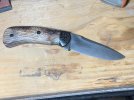- Joined
- Jun 3, 2019
- Messages
- 2,714
This has been kind of talked about in the past, but I think not explicitly in this way...
I am about to start on a handle for a kitchen knife (Nakiri, but with western style handle) for a friend .... and I am thinking about using the opportunity to take a first stab at a multi-part handle (long rear portion one wood, but with another type of wood towards the front of the handle as a "bolster). But ..... how the heck to you get everything lined up???? Here is what I am considering:
Would this approach work? Does anyone have any other approach?
(I know horsewright just glues everything up in one single step .... but he is a magician, and I could not possibly hope to replicate... :-(
I am about to start on a handle for a kitchen knife (Nakiri, but with western style handle) for a friend .... and I am thinking about using the opportunity to take a first stab at a multi-part handle (long rear portion one wood, but with another type of wood towards the front of the handle as a "bolster). But ..... how the heck to you get everything lined up???? Here is what I am considering:
- start with blocks (not scales), and glue front piece to back piece (with spacer between maybe). Then drill a single hole through the front piece to coincide with the location of the front pin/corby.
- Then .... rip the thing lenghwise into two "scales". The hole now becomes an alignment reference. add spacer to inside of each scale (if wanted)
- put one scale onto the tang with alignment pin through hole and front hole in the tang (already drilled in tang). Drill out the other holes (two more of them) through the other pre-drilled holes in the tang.
- put other side scale onto the tang, and drill out holes in that side (drilling through from the side that has already had holes drilled.
- Remove scales, and with alignment pins in place, shape/finish front of handle.
- Glue up scales to handle (using corbys, or temporary alignment pins, as wanted).
- shape and finish handle as for any single piece handle (for pins, I shape and near-finish, t then ream holes and insert and peen pins).
Would this approach work? Does anyone have any other approach?
(I know horsewright just glues everything up in one single step .... but he is a magician, and I could not possibly hope to replicate... :-(

